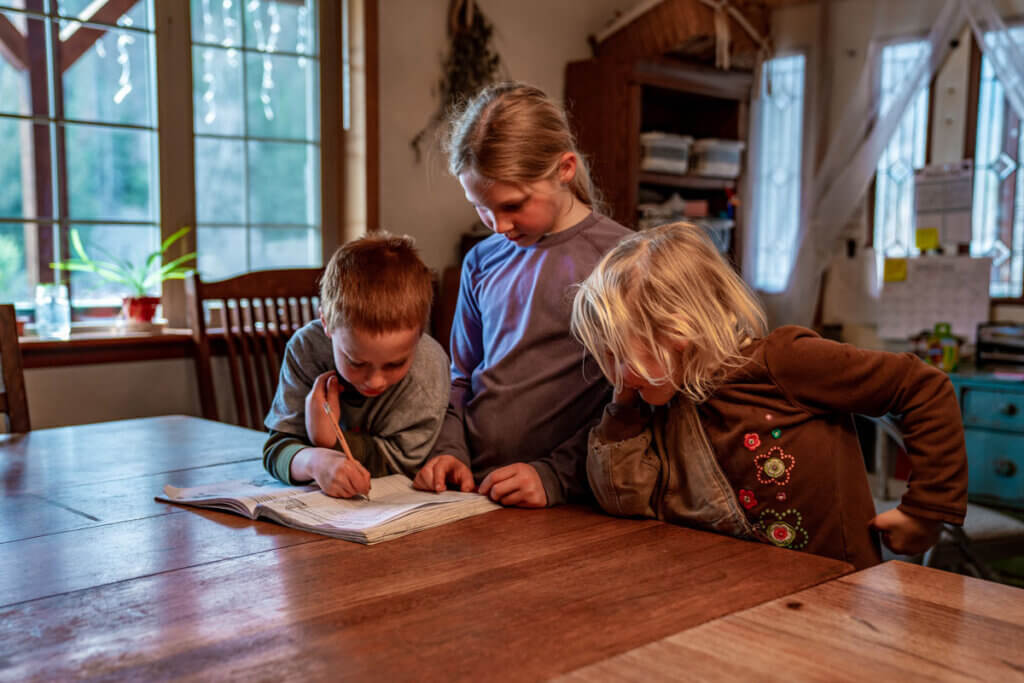I’m excited to share with you a delightful and creative activity that is not only fun but also safe for your little ones – homemade edible playdough!

While there are many times homesteading with children leads to creative experiments, this is one craft we like to do often here on the homestead. While training our children to have a productive morning, keeping consistent daily routines, and teaching the importance of chore times, it’s also important to have some good old-fashioned fun.
That’s where DIY bubble solution, fun apple stamping, and homemade playdough come in!

Table of Contents
ToggleWhy I Love Edible Playdough
Imagine the joy on your child’s face as they mold and create with their own delectable playdough creations. Making edible playdough couldn’t be easier, and I’ll provide you with some fantastic recipe variations and explain why edible playdough is a fantastic choice for young children.
One word of caution with this recipe, because it calls for honey and peanut butter, it’s advised not to make this recipe for children under 12 months of age. But for the older kids, it’s a great craft at snacktime to get their imaginations going and their bellies filled with a fun treat.
It’s not every day mom says you can play with your food!

What Is Edible Playdough
Edible playdough, as the name suggests, is a type of playdough that is safe to eat. It’s a fantastic way to engage children in sensory play while ensuring their safety and enjoyment.
Unlike traditional playdough, which is not meant to be consumed, edible playdough is made from simple ingredients that are safe for ingestion. It’s free from any harmful chemicals, making it an ideal option for curious little ones who love to explore with their senses.
One of the greatest advantages of edible playdough is that you can make it at home with just a few ingredients. It’s a fun and creative activity that you and your child can enjoy together. Not only does it provide endless hours of entertainment, but it also offers a sensory experience that can help develop fine motor skills and stimulate a child’s imagination.

Activities for Kids Using Homemade Playdough
The beauty of homemade edible playdough lies not only in its safety but also in the wide range of activities it offers for children. From sensory exploration to imaginative play, there’s no shortage of fun ways to engage kids using this versatile substance.
Here are a few exciting activities for kids that can be enjoyed with homemade playdough:
- Creating Sculptures – Let your child’s imagination run wild as they mold and shape the edible playdough into various objects, animals, or even their favorite characters.
- Playing Pretend – Use the edible playdough as props during pretend play sessions. They can pretend to be a chef, a baker, or an artist, creating their own mini masterpieces.
- Learning Shapes and Letters – Roll out the playdough into flat surfaces and use cookie cutters or letter stamps to help children learn shapes and letters in a fun and interactive way.
- Make a Special Lunch – This recipe for edible playdough is really rich, so a small serving for each child is recommended. Serve with fruit and vegetable slices, coconut flakes, chocolate chips, homemade crackers, cheese sticks, tortillas, or other fun “building blocks,” and encourage your children to make snowmen, buildings, vehicles, animals, etc.

Why Does My Child Eat Playdough?
One common concern among parents is why their children are drawn to eating playdough. As strange as it may seem, this behavior is actually quite common among young kids.
- The Sensory Appeal – Children, especially toddlers, often explore the world around them through their senses. Playdough, with its vibrant colors and squishy texture, is incredibly appealing to them. It’s no wonder that some kids can’t resist taking a taste!
- Curiosity and Exploration – Children are naturally curious beings, and tasting playdough is just another way for them to understand their environment. When they see other children playing with playdough, they might wonder what it tastes like and feel compelled to try it themselves.
- Imitating Real-Life Activities – Children often imitate the actions they see adults doing. They observe parents cooking, baking, and working with various materials. When they see adults using dough in the kitchen or sculpting with clay, they might mistake playdough for something edible and attempt to eat it.
While it’s perfectly normal for young children to be curious and engage in sensory exploration, it’s important to ensure their safety. Playdough (aka Play-Doh), in its traditional form, is not meant to be consumed. That’s why edible playdough exists as a safer alternative.
So, the next time your child reaches for a bite of playdough, remember that it’s just their way of experiencing the world. By offering them edible playdough, you’re encouraging their sensory development while ensuring a fun and safe playtime experience!

How Long Will Edible Playdough Keep
While the shelf life of edible playdough can vary depending on the recipe and storage conditions, there are a few general guidelines to keep in mind.
- Moisture Content – The moisture content in edible playdough plays a crucial role in determining its shelf life. Playdough with higher moisture content tends to spoil more quickly. To ensure your edible playdough lasts longer, make sure to follow the recipe carefully and avoid adding any additional liquids.
- Quality Ingredients – Using fresh and high-quality ingredients in your homemade playdough recipes can contribute to its longevity. Ensure that your ingredients are fresh and within their expiration dates.
- Storage – Proper storage is essential for maintaining the freshness of edible playdough. If you are making your edible playdough ahead of time, store it in an airtight container or ziplock bag to prevent it from drying out or becoming contaminated. Keep it in a cool and dry place, away from direct sunlight or heat sources.
Homesteading Hack: This recipe can be made ahead and stored for future use but is not intended to be reused. Make up a large batch and take out only enough for each child, storing the rest in the refrigerator for more fun the next day.

Supplies Needed
- Mixing Bowl – A large mixing bowl will allow you to incorporate all ingredients adequately.
- Measuring Cup – Homesteading Hack: Spray with some DIY non-stick cooking spray before measuring your ingredients. This will allow the honey and peanut butter to slide out with ease, making cleanup a snap!
- Mixing Spoon – Edible playdough can be mixed by hand, but if using a spoon, make sure it’s sturdy.
Ingredients Needed
This recipe can be scaled up or down as needed. The key is just to remember to use equal parts of each ingredient.
- Smooth/Creamy Peanut Butter – Old-fashioned peanut butter without added sugars or oils is best. Cashew or almond butter can be substituted.
- Honey – We use raw local honey.
- Powdered Milk – We use organic whole milk powder for this recipe.



How to Make Edible Playdough
- Combine all three ingredients in a large mixing bowl.
- Mix with a wooden spoon until all the ingredients are incorporated and come together to form a dough.
- Store in a sealed container until ready to use.
- Discard any used playdough that did not get consumed.
By incorporating homemade edible playdough into your child’s playtime routine, you open up a world of possibilities for their creativity. From molding fun shapes and exploring different textures to enjoying a fun snack or lunch, your child will delight in the hands-on experience of shaping their own playdough creations.
Did you make this edible playdough? If so, please leave a star rating in the recipe card below. Then, snap a photo of your creations and tag us on social media @homesteadingfamily so we can see!

FAQ
Edible playdough is a type of playdough that is safe for young children to consume. It is made with edible ingredients, allowing kids to have fun playing with it and even tasting it.
Making homemade edible playdough is easy and fun. You can find various recipes online that use simple ingredients like flour, salt, vegetable oil, and gel food coloring. However, this recipe uses peanut butter, honey, and powdered milk to make a delicious treat.
Kids love edible playdough because it allows them to engage their senses while playing. They can explore different textures, shapes, and even taste the playdough, making it a sensory-rich and enjoyable experience.
Regular playdough that is not labeled as edible should not be consumed as it is not designed for ingestion and may contain harmful chemicals. However, edible playdough recipes are specifically made with safe ingredients, making them a safer option for young children.
The shelf life of homemade edible playdough can vary depending on the recipe and storage conditions.

Other Posts You May Enjoy
- Tips for Homesteading With Children
- Educating Children Through Homesteading
- Homeschool Tips for Beginners
- Daily Routine for Kids on the Homestead
- Teaching Our Children To Have a Productive Morning
- The Importance of Chore-Time for Kids
- How to Get 3 Home-Cooked Meals on the Table Every Day
- The Importance of a Healthy Breakfast

Edible Playdough Recipe
Equipment
- Mixing Bowl
- Measuring Cup spray with non-stick cooking spray before measuring honey and peanut butter so it slides out with ease.
- spatula or mix with your hands!
Ingredients
- 1 cup creamy peanut butter
- 1 cup honey
- 1 cup powdered milk
Instructions
- Combine all three ingredients in a large mixing bowl.
- Mix with a wooden spoon until all the ingredients are incorporated and come together to form a dough.
- Store in a sealed container until ready to use.
- Discard any used playdough that did not get consumed.
Notes
- One word of caution with this recipe, because it calls for honey and peanut butter, it’s advised not to make this recipe for children under 12 months of age. But for the older kids, it’s a great craft at snacktime to get their imaginations going and their bellies filled with a fun treat.


















